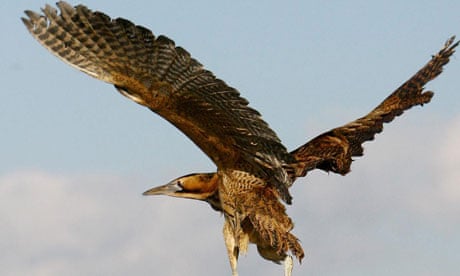Britain's loudest bird, the bittern, has had its best year since records began with scientists tracking more than 100 breeding males belting out their distinctive booming call.
The bittern – a relative of the grey heron – was classed as extinct in the UK in the late 19th century and as recently as 1997 there were thought to be only 11 males left but following efforts to restore its reed-bed habitat, the Royal Society for the Protection of Birds (RSPB) and Natural England now believes 104 booming males have been at large this year.
The other good news for bitterns and their fans is that the bird's range seems to be increasing. Most were found in its marshy East Anglian heartland (where the birds are still sometimes known as butterbumps) but healthier populations are now also doing well on the Somerset Levels in the south-west of England.
The natural environment minister Richard Benyon led the chorus of approval. "To see a species that was once extinct in the UK rise to a population of over one hundred is a real achievement," he said.
"This is largely down to the work of the RSPB and Natural England, and shows what can be achieved if we work together."
The bittern was common in west and central Europe until the 19th century. In the UK they were hunted for the dinner table and also suffered because their watery homes were drained for farmland.
They were judged extinct in the UK by 1885 but then made a comeback so that by the 1950s there were some 80 booming males. The loss of further reed-beds led to them declining once more.
It remains difficult to be precise about how many bitterns remain because they are so secretive, living most of their lives within dense reeds.
But the males' call, which is created by them filling their gullets with air and then releasing it, gives them away. It can be heard at a distance of several miles, enabling scientists to count them.
Surveyors pinpointed 33bitterns in Suffolk compared with four in 1997, 25 in Somerset (against one 14 years ago) and 23 in Norfolk (compared with three). Smaller numbers were also heard in other counties, including Cambridgeshire and Lincolnshire.
Martin Harper, the RSPB's conservation director, said: "To lose the bittern once in Britain was regrettable, but to have lost it twice would have been unforgivable.
"Concern for the bittern in the 1990s led to an intensive species-recovery programme, with research and habitat improvement and creation playing major roles. Focused work on bitterns has led to great gains for reed-beds and all the wildlife associated with this priority habitat."
The bittern still faces threats, including sea level rise, where freshwater sites along the coast could be inundated by saltwater.
Pete Brotherton, Natural England's head of biodiversity said: "The bittern's recovery shows what can be done when government, conservationists and landowners work together.
"This is an encouraging sign that we can restore and improve our wetland habitats, which bring vital benefits to both people and wildlife."

Comments (…)
Sign in or create your Guardian account to join the discussion